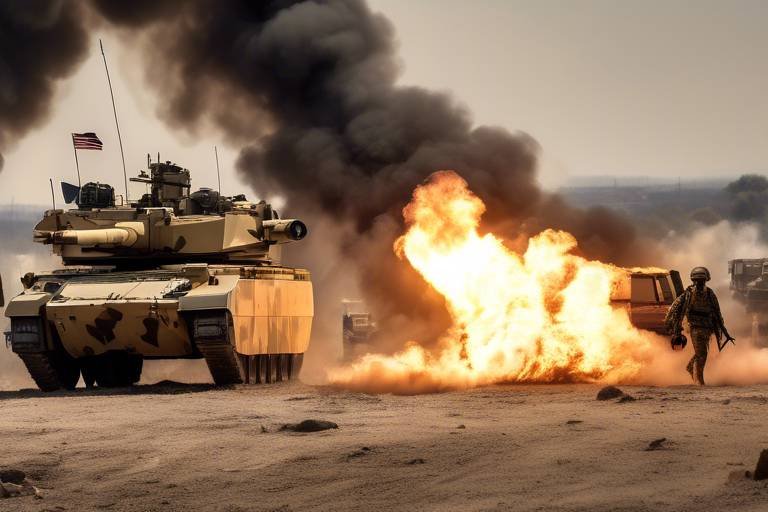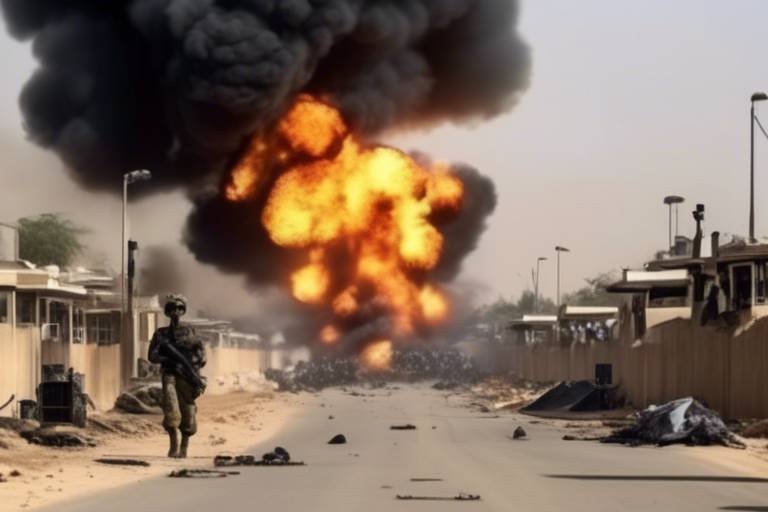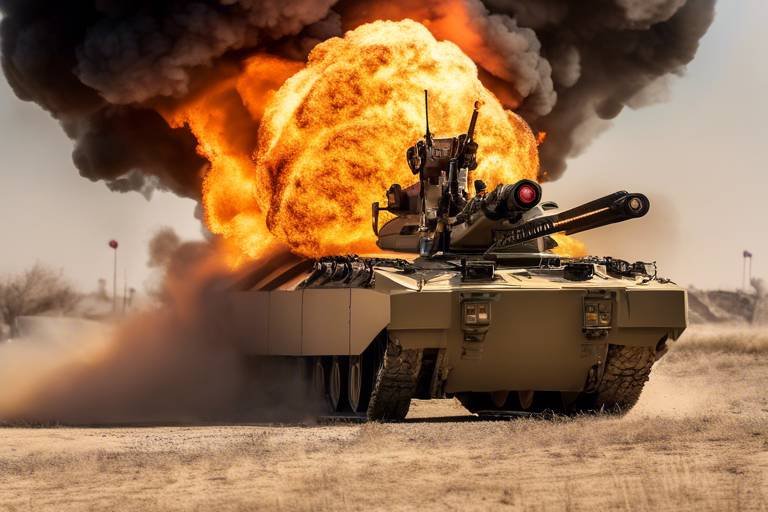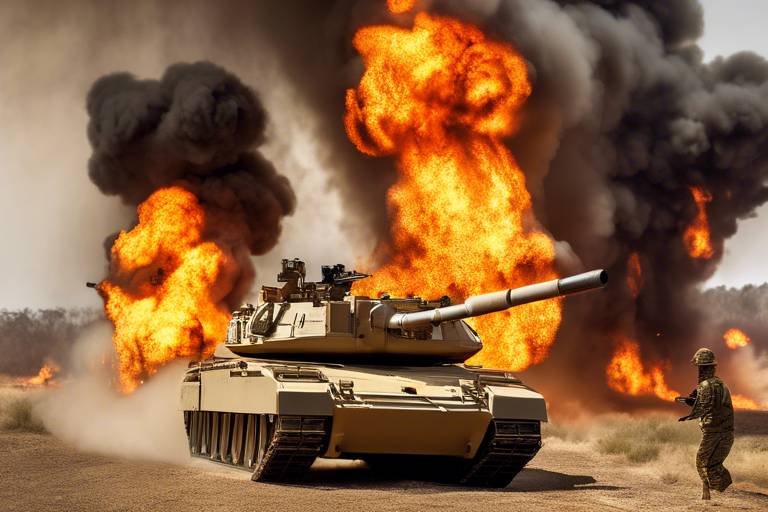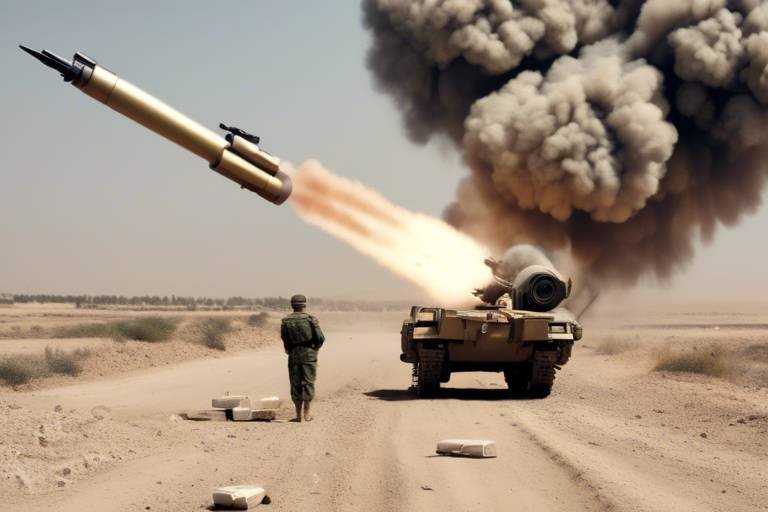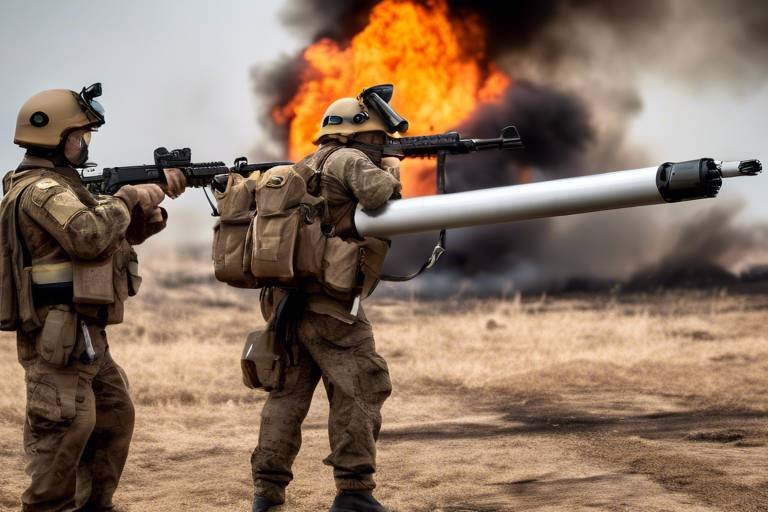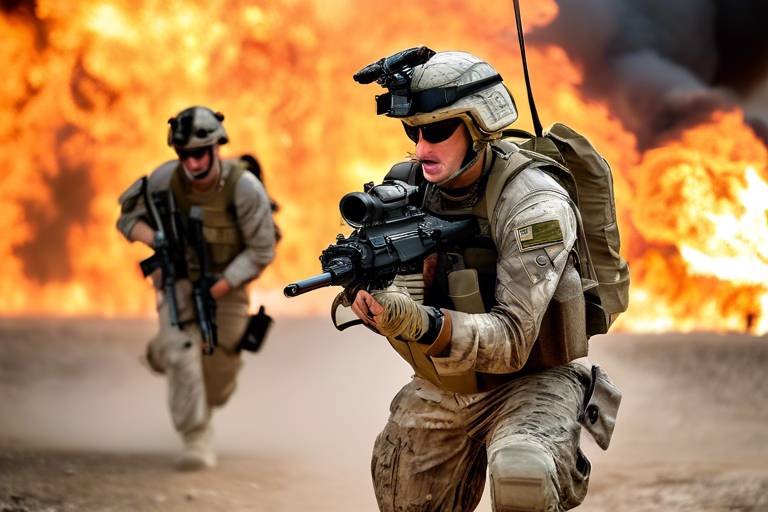Comparing Conventional and Unmanned Aerial Attack Systems
In the ever-evolving landscape of modern warfare, the comparison between conventional military attack systems and unmanned aerial vehicles (UAVs) has become a hot topic. These two distinct approaches to aerial assault not only showcase different technological advancements but also reflect changing military strategies and operational philosophies. As we delve into this comparison, we will explore their operational capabilities, strategic advantages, and the future implications they hold for warfare. The question arises: how do these systems measure up against each other, and what does this mean for the future of military engagements?
The roots of aerial warfare stretch back over a century, beginning with rudimentary aircraft used in World War I. As the years progressed, we witnessed a dramatic evolution in technology and strategy. From the iconic bombers of World War II to the advanced fighter jets of today, each era has contributed to a rich tapestry of aerial combat history. Understanding this evolution sheds light on how conventional and unmanned systems have developed. Notably, the introduction of UAVs in the late 20th century marked a significant shift, allowing military forces to engage in operations without putting pilots at risk. This transformation raises intriguing questions about the future of combat and the role of human operators in warfare.
When examining the operational capabilities of conventional attack systems versus UAVs, several key factors come into play. These include range, payload capacity, and versatility in various combat scenarios. Conventional systems, like fighter jets and bombers, boast impressive range and firepower, capable of delivering heavy payloads across vast distances. However, UAVs have emerged as formidable contenders, offering unique advantages such as extended flight durations and the ability to operate in environments that may be too dangerous for manned aircraft.
Conventional aerial attack systems have long been revered for their firepower and the expertise of human pilots. The experience and intuition of a skilled pilot can often make the difference in high-stakes combat situations. These systems are designed to engage directly with enemy forces, utilizing advanced weaponry and tactics honed over decades of military tradition. For instance, the ability to perform complex maneuvers and engage in dogfights offers a level of tactical flexibility that UAVs currently cannot match. However, this strength comes with its own set of challenges.
Despite their strengths, conventional systems face significant challenges. One major limitation is their vulnerability to enemy defenses, particularly in modern warfare where anti-aircraft technology is becoming increasingly sophisticated. Additionally, the presence of human pilots introduces risks, as they are exposed to the dangers of combat zones. The loss of a pilot not only has humanitarian implications but also affects morale and operational effectiveness. As a result, military strategists are increasingly considering the benefits of incorporating UAVs into their operations.
The world of unmanned aerial vehicles has witnessed remarkable technological innovations in recent years. UAVs are now equipped with advanced sensors and precision strike capabilities, enabling them to conduct surveillance and targeted attacks with minimal risk to human life. These advancements have transformed UAVs into essential tools for modern militaries, allowing for real-time intelligence gathering and strategic strikes in hostile environments. The ability of UAVs to operate remotely means that they can be deployed in dangerous situations without endangering personnel, making them a game-changer in military operations.
UAVs offer unique advantages that conventional systems cannot match. Firstly, they typically have lower operational costs, which makes them appealing for prolonged engagements. Additionally, the safety of operators is significantly enhanced, as UAVs can be flown from secure locations far from the battlefield. This capability allows military forces to conduct missions in hostile environments without risking human lives. Furthermore, UAVs can conduct missions that require prolonged surveillance or reconnaissance, making them invaluable assets in modern warfare.
The strategic implications of using conventional versus unmanned systems in military operations are profound. The integration of UAVs is reshaping military doctrine, emphasizing the importance of adaptability and technological superiority. As armed forces adapt to these new realities, decision-making processes, resource allocation, and overall military effectiveness are being redefined. The shift towards unmanned systems is not just a trend; it signifies a fundamental change in how wars are fought.
The incorporation of UAVs into military doctrine is reshaping how armed forces approach warfare. With their ability to gather intelligence and conduct strikes with precision, UAVs are becoming central to modern military strategies. This evolution emphasizes the need for flexibility and responsiveness in military operations, allowing forces to adapt quickly to changing battlefield dynamics.
As we look to the future, several trends in aerial warfare are becoming apparent. There is likely to be an increased reliance on unmanned systems, with advancements in technology continuing to enhance their capabilities. Additionally, we may see the emergence of hybrid models that combine the strengths of both conventional and UAV technologies. This convergence could lead to a new era of aerial warfare, where the lines between manned and unmanned systems blur, creating a more dynamic and effective combat environment.
- What are the primary differences between conventional and unmanned aerial systems?
Conventional systems rely on human pilots and often have greater firepower, while UAVs operate remotely, offering safety and lower operational costs. - How have UAVs changed modern warfare?
UAVs have introduced new strategies and tactics, allowing for precision strikes and surveillance without risking human lives. - What does the future hold for aerial warfare?
Future trends indicate a growing reliance on unmanned systems and the potential for hybrid models that integrate both conventional and UAV technologies.
Historical Context of Aerial Warfare
The history of aerial warfare is a fascinating journey that has transformed the landscape of military strategy. It all began in the early 20th century, during World War I, when the first powered aircraft took to the skies for military purposes. These primitive biplanes were primarily used for reconnaissance, but soon they evolved into more offensive roles, dropping bombs on enemy positions. The introduction of aerial combat changed the dynamics of warfare, making it essential for military leaders to consider air superiority as a crucial factor in their strategies.
As we moved into World War II, the role of aircraft expanded dramatically. The development of faster, more powerful planes allowed for strategic bombing campaigns that targeted not only military installations but also civilian infrastructure. This marked a significant shift in the perception of aerial warfare, as it became clear that controlling the skies could dictate the outcome of ground battles. The infamous Blitzkrieg tactics employed by Germany showcased how air power could be integrated with ground forces to achieve rapid victories.
Following WWII, the Cold War era saw the emergence of jet technology and the introduction of guided missiles, which further revolutionized aerial combat. The Korean War was notable for the first widespread use of jet fighters, while the Vietnam War highlighted the effectiveness of helicopters and close air support. It was during this time that the concept of using unmanned systems began to take shape. The Vietnam War saw the deployment of drones for reconnaissance, laying the groundwork for the advanced UAVs we see today.
Fast forward to the 21st century, and the landscape of aerial warfare has changed yet again with the introduction of sophisticated unmanned aerial vehicles (UAVs). The technological advancements in sensors, communication, and automation have made UAVs a game-changer on the battlefield. Today, they are not just tools for surveillance but also platforms for precision strikes, capable of executing missions with minimal risk to human life. This evolution reflects a broader trend in military strategy, where the emphasis is increasingly on remote warfare and minimizing casualties.
To illustrate the evolution of aerial warfare, consider the following table that summarizes key milestones:
| Era | Key Developments | Impact on Warfare |
|---|---|---|
| WWI | First military aircraft, reconnaissance missions | Introduction of air power in combat |
| WWII | Strategic bombing, development of fighter jets | Air superiority becomes crucial for victory |
| Cold War | Jet technology, introduction of guided missiles | Integration of air and ground forces |
| 21st Century | Advanced UAVs, precision strikes | Shift towards remote warfare and risk minimization |
In conclusion, the historical context of aerial warfare reveals a continuous evolution driven by technological advancements and changing military doctrines. From the biplanes of WWI to the sophisticated drones of today, each phase has brought about new strategies and implications for how wars are fought. Understanding this history is essential for grasping the current dynamics between conventional and unmanned aerial attack systems, as well as their future implications in warfare.
- What was the first use of aircraft in warfare? Aircraft were first used for reconnaissance during World War I.
- How did aerial warfare change during World War II? Aerial warfare evolved to include strategic bombing and the use of fighter jets, making air superiority a key factor in military success.
- What role do UAVs play in modern warfare? UAVs are used for surveillance, reconnaissance, and precision strikes, allowing for missions to be carried out with reduced risk to human lives.
- How has technology impacted aerial warfare? Technological advancements have led to faster, more capable aircraft and drones, fundamentally changing military strategies and operations.
Operational Capabilities
When we dive into the of conventional military attack systems versus unmanned aerial vehicles (UAVs), we uncover a fascinating landscape of strengths and weaknesses. Both categories of aerial warfare tools have been designed with specific objectives in mind, yet they operate under very different paradigms. Conventional systems, such as fighter jets and bombers, are often celebrated for their firepower and the invaluable experience that human pilots bring to the battlefield. These aircraft can carry substantial payloads, execute complex maneuvers, and engage in dogfights, showcasing their versatility in various combat scenarios.
On the flip side, UAVs have revolutionized the battlefield with their unique capabilities. These drones are not bound by the same physical and psychological limitations as their manned counterparts. For instance, UAVs can operate at altitudes and in environments that might be too risky for human pilots. They can loiter over a target for extended periods, gathering intelligence or waiting for the perfect moment to strike. This endurance is a game changer, allowing for a level of operational flexibility that traditional systems simply can't match.
To illustrate the differences in operational capabilities, let's take a closer look at some key factors:
| Capability | Conventional Systems | Unmanned Aerial Vehicles (UAVs) |
|---|---|---|
| Range | Long-range capabilities, often exceeding 1,000 miles | Varies; some UAVs can operate remotely over vast distances |
| Payload Capacity | Heavy payloads, including bombs and missiles | Generally lighter payloads, but highly specialized for precision strikes |
| Versatility | Highly versatile in air-to-air and air-to-ground combat | Excellent for surveillance, reconnaissance, and targeted strikes |
| Operational Risk | High risk to pilot and aircraft | Minimal risk to human life; remote operation |
This comparison highlights a crucial point: while conventional systems excel in delivering powerful strikes and engaging in direct combat, UAVs shine in their ability to operate safely and effectively in hostile environments. The ability to conduct missions without risking a pilot's life is a significant advantage, particularly in modern warfare where the battlefield is increasingly unpredictable.
Moreover, the cost-effectiveness of UAVs cannot be overlooked. With lower operational costs and maintenance requirements, they allow military forces to allocate resources more efficiently. In a world where every dollar counts, this aspect becomes increasingly vital. As we look to the future, the evolution of these operational capabilities will likely continue to shape military strategies and the very nature of warfare itself.
Advantages of Conventional Systems
When it comes to aerial warfare, conventional systems have carved out a niche that is hard to overlook. One of the most significant advantages of these systems is their firepower. Equipped with advanced weaponry and munitions, conventional aircraft can deliver devastating strikes that can turn the tide of battle in an instant. Imagine a fighter jet soaring through the skies, armed to the teeth and ready to unleash a barrage of precision-guided missiles. This raw power not only intimidates adversaries but also provides a level of deterrence that unmanned systems often struggle to achieve.
Moreover, the experience and skill of human pilots cannot be understated. These pilots undergo rigorous training, honing their abilities to make split-second decisions in high-pressure situations. Their situational awareness and tactical acumen allow them to adapt to rapidly changing combat scenarios, something that unmanned systems, despite their technological prowess, may not fully replicate. In many cases, the human touch in piloting can be the difference between success and failure in a mission.
Another advantage lies in the versatility of conventional systems. They can be deployed in a wide range of roles, from air superiority to ground attack and even reconnaissance. This adaptability allows military forces to tailor their aerial capabilities to meet specific operational needs. For instance, a single fighter jet can switch from engaging enemy aircraft to providing close air support for ground troops, showcasing its multifaceted utility.
Additionally, conventional systems often have a longer operational range and greater payload capacity compared to their unmanned counterparts. This means they can carry more weapons and supplies, allowing for sustained operations without the need for frequent refueling or resupply. In scenarios where every second counts, having that extra firepower and range can be a game changer.
While there are undeniable advantages to conventional systems, it’s essential to recognize that they also come with their own set of challenges. Yet, the strengths they bring to the battlefield—firepower, pilot expertise, versatility, and operational range—make them indispensable in modern warfare. As military strategies evolve, the role of conventional systems will continue to be significant, even as unmanned systems gain traction.
- What are the primary advantages of conventional aerial systems?
Conventional systems offer superior firepower, experienced pilots, versatility in roles, and greater operational range and payload capacity. - How do human pilots enhance the effectiveness of conventional systems?
Human pilots bring situational awareness and tactical decision-making skills that can adapt to rapidly changing combat scenarios. - Are conventional systems still relevant in the age of UAVs?
Yes, conventional systems remain crucial due to their unique advantages, despite the rise of unmanned aerial vehicles.
Limitations of Conventional Systems
While conventional aerial attack systems have proven their worth in numerous conflicts, they are not without their limitations. One of the most significant challenges is their vulnerability to enemy defenses. As technology advances, adversaries have developed increasingly sophisticated anti-aircraft systems, making it perilous for manned aircraft to operate in contested airspace. Imagine sending a fighter jet into a storm without radar; that’s akin to what pilots face when navigating through areas with heavy anti-aircraft capabilities.
Additionally, the presence of human pilots introduces a layer of risk that unmanned systems can sidestep. Pilots are not just operating complex machinery; they are also subject to physical and psychological stresses. High-stakes combat situations can lead to fatigue, which might impair decision-making. This is a stark contrast to UAVs, which can be operated remotely, allowing for longer missions without the same level of human strain.
Moreover, conventional systems often require extensive logistical support. This includes maintenance, fuel, and crew training, all of which can be costly and time-consuming. In a world where military budgets are constantly scrutinized, these factors can limit the number of missions a conventional aircraft can undertake compared to UAVs, which can be deployed more rapidly and with fewer resources. For instance, consider the difference in deployment time: a conventional fighter jet may take hours to prepare, while a UAV can be ready to go in a matter of minutes.
Another limitation is the operational range of conventional systems. While they are capable of covering large distances, their effectiveness diminishes in hostile environments where air superiority has not been established. This often necessitates support from other aircraft or ground forces, complicating mission execution. In contrast, UAVs can operate from a distance, conducting surveillance or strikes without needing to establish air dominance first. This flexibility allows for a broader range of operational scenarios, making UAVs a more versatile choice for modern warfare.
In summary, while conventional aerial attack systems have their strengths, they also face significant limitations that can hinder their effectiveness in contemporary combat scenarios. As we continue to evolve in our military strategies and technologies, understanding these limitations will be crucial in shaping future defense capabilities.
- What are the primary limitations of conventional attack systems?
The primary limitations include vulnerability to enemy defenses, risks associated with human pilots, extensive logistical support requirements, and operational range constraints.
- How do unmanned aerial vehicles (UAVs) overcome these limitations?
UAVs can operate remotely, reducing risks to human life, and they require less logistical support, allowing for quicker deployment and greater operational flexibility.
- What impact do these limitations have on military strategy?
These limitations can affect decision-making and resource allocation, leading military forces to increasingly rely on UAVs for a variety of missions.
Technological Innovations in UAVs
The world of unmanned aerial vehicles (UAVs) is experiencing a remarkable transformation, driven by rapid technological innovations that are redefining their role in modern warfare. Imagine a bird soaring through the sky, but instead of feathers and wings, it has advanced sensors, cameras, and sophisticated software. This is the essence of UAVs today. The advancements in technology have not only enhanced their operational capabilities but have also made them indispensable tools for military strategists.
One of the most significant innovations in UAV technology is the integration of artificial intelligence (AI). With AI, UAVs can analyze vast amounts of data in real-time, allowing them to make informed decisions autonomously. This capability is particularly useful in surveillance missions where quick assessments can determine the success or failure of an operation. Think of it as having a highly trained assistant who can process information faster than a human ever could, significantly improving situational awareness on the battlefield.
Furthermore, advancements in sensor technology have allowed UAVs to gather intelligence with unprecedented precision. Modern UAVs are equipped with high-resolution cameras and advanced radar systems that can detect and identify targets from miles away. This level of detail not only enhances reconnaissance missions but also supports precision strikes, minimizing collateral damage. In essence, the clearer the picture, the more effective the strike—it's like using a microscope to see the tiniest details that would otherwise go unnoticed.
Another remarkable innovation is the development of swarming technology. This concept involves deploying multiple UAVs that can operate in unison, communicating with each other to accomplish complex missions. When these drones work together, they can overwhelm enemy defenses, create diversions, or cover vast areas in surveillance operations. Imagine a flock of birds moving as one; this is the power of swarming technology in action—agile, adaptable, and formidable.
Moreover, improvements in battery life and propulsion systems have significantly extended the operational range of UAVs. Modern drones can now fly longer distances without needing to return for refueling, allowing them to conduct extended missions in hostile territories. This capability reduces the frequency of resupply missions, which often expose conventional aircraft to enemy fire. Picture a marathon runner who can go the distance without stopping for a breather—this is what enhanced battery technology has achieved for UAVs.
Finally, the integration of secure communication systems ensures that UAVs can operate in contested environments without the risk of being hacked or jammed by enemy forces. This security layer is crucial, as it protects sensitive data and maintains operational integrity. Think of it as a secret code that only trusted allies can decipher, keeping the enemy in the dark while allowing for effective coordination among friendly units.
In conclusion, the technological innovations in UAVs are not just incremental improvements; they represent a paradigm shift in how military operations are conducted. From AI and sensor advancements to swarming technology and enhanced security, these innovations are setting the stage for a future where UAVs play a pivotal role in aerial warfare. As we look ahead, it’s clear that the skies will be dominated by these sophisticated machines, fundamentally changing the landscape of military strategy.
- What are UAVs used for in military operations? UAVs are primarily used for surveillance, reconnaissance, and precision strikes, providing valuable intelligence and reducing risks to human pilots.
- How does AI enhance UAV capabilities? AI enables UAVs to process data in real-time, make autonomous decisions, and improve situational awareness, making them more effective in various missions.
- What is swarming technology? Swarming technology involves multiple UAVs working together to accomplish missions, enhancing their effectiveness by overwhelming enemy defenses.
- Why are secure communication systems important for UAVs? Secure communication systems protect UAV operations from enemy interference, ensuring that sensitive data remains confidential and operational integrity is maintained.
Advantages of Unmanned Systems
Unmanned Aerial Vehicles (UAVs) have revolutionized modern warfare, offering a plethora of unique advantages that make them indispensable in military operations. One of the most significant benefits of UAVs is their lower operational costs. Unlike traditional aircraft, which require extensive maintenance, fuel, and pilot training, UAVs can often be operated at a fraction of the cost. This cost-effectiveness allows military forces to allocate resources more efficiently, enabling them to conduct more frequent missions without breaking the bank. Imagine being able to launch a series of airstrikes without the hefty price tag that typically accompanies conventional aircraft; this is the reality that UAVs bring to the table.
Another compelling advantage is the enhanced safety for operators. With UAVs, the risk to human life is significantly reduced. Pilots can operate these drones from safe distances, often thousands of miles away from the combat zone, eliminating the dangers posed by enemy fire and hostile environments. This is akin to playing a video game where you control a character in a dangerous world, but you’re safely tucked away in your living room. The ability to conduct surveillance and engage targets without putting pilots in harm's way is a game-changer in military strategy.
Furthermore, UAVs are designed to conduct missions in hostile environments that may be too dangerous for manned aircraft. They can fly at lower altitudes, navigate through complex terrains, and operate in adverse weather conditions without the limitations that come with human pilots. This versatility makes them incredibly effective for reconnaissance and precision strikes, allowing military forces to gather intelligence and execute operations with pinpoint accuracy.
In addition to these operational benefits, UAVs are equipped with advanced technologies that enhance their effectiveness. For instance, many UAVs come with real-time data transmission capabilities, allowing commanders to receive live feeds from the battlefield. This immediate access to information can significantly improve decision-making processes, enabling forces to adapt quickly to changing circumstances on the ground.
To summarize, the advantages of unmanned systems can be encapsulated in the following key points:
- Lower Operational Costs: More missions for less money.
- Enhanced Safety: Protects human lives by keeping pilots out of harm's way.
- Versatility in Hostile Environments: Operates effectively in dangerous conditions.
- Advanced Technologies: Provides real-time data for improved decision-making.
As we move forward, the role of UAVs in military operations will likely continue to expand. Their ability to adapt to various combat scenarios while minimizing risks makes them a vital component of modern warfare strategies. The future of aerial combat is undoubtedly intertwined with the evolution of unmanned systems, and understanding these advantages is crucial for grasping the changing landscape of military engagements.
Q1: What are UAVs primarily used for in military operations?
A1: UAVs are primarily used for surveillance, reconnaissance, and precision strikes. They provide real-time intelligence and can engage targets without risking human lives.
Q2: How do UAVs reduce operational costs?
A2: UAVs require less maintenance, fuel, and training compared to conventional aircraft, allowing for more frequent missions at a lower overall cost.
Q3: Are there any risks associated with using UAVs?
A3: While UAVs reduce risks to human pilots, they can still be vulnerable to enemy defenses and may face challenges related to cybersecurity and remote operation failures.
Strategic Implications
The strategic implications of utilizing conventional military attack systems versus unmanned aerial vehicles (UAVs) are profound and multifaceted. As the landscape of warfare continues to evolve, the choices military leaders make regarding aerial capabilities can significantly influence decision-making, resource allocation, and overall military effectiveness. The integration of UAVs into military operations is not merely a trend; it represents a fundamental shift in how armed forces approach conflict and engage with adversaries.
One of the most striking implications of this shift is the adaptability that UAVs offer. Unlike conventional systems, which often require extensive training and infrastructure, UAVs can be deployed more rapidly and with less logistical burden. This flexibility allows military leaders to respond to emerging threats swiftly, making it easier to adapt to the dynamic nature of modern warfare. For instance, in scenarios where time is of the essence, the ability to launch a UAV for reconnaissance or precision strikes can be the difference between success and failure.
Moreover, the incorporation of unmanned systems into military doctrine is reshaping the concept of technological superiority. As nations invest in advanced UAV technologies, the emphasis is increasingly on leveraging cutting-edge capabilities to gain a strategic edge over adversaries. This technological race has led to an arms escalation, where countries are not only enhancing their UAV fleets but also developing countermeasures against them. The result is a complex battlefield where both conventional and unmanned systems must coexist and complement each other.
To illustrate the impact of these strategic implications, consider the following table that outlines key differences in operational focus between conventional and unmanned systems:
| Aspect | Conventional Systems | Unmanned Systems |
|---|---|---|
| Operational Flexibility | Limited by pilot availability and aircraft readiness | Highly flexible; can be deployed quickly and remotely |
| Risk to Personnel | High; pilots are in harm's way | Low; no human presence in combat zones |
| Cost Efficiency | Higher operational costs due to maintenance and personnel | Lower costs; fewer resources needed for operation |
| Technological Advancements | Slow; reliant on existing aircraft technology | Rapid; constant innovation in UAV capabilities |
As we look to the future, it’s essential to consider how these strategic implications will shape military operations. The increasing reliance on UAVs suggests a potential shift towards hybrid models that combine the strengths of both conventional and unmanned systems. This hybrid approach could lead to a more integrated force structure, where traditional aircraft and UAVs work together seamlessly to achieve mission objectives.
In conclusion, the strategic implications of choosing between conventional and unmanned aerial attack systems are significant. They affect not only how military forces operate but also how they plan for the future. As technology continues to advance, the dialogue around these systems will only grow more complex, urging military leaders to remain agile and forward-thinking in their strategies.
- What are the primary advantages of UAVs over conventional systems?
UAVs offer lower operational costs, enhanced safety for operators, and greater flexibility in deployment. - How do UAVs impact military decision-making?
UAVs allow for quicker responses to threats and provide real-time intelligence, which can significantly influence strategic decisions. - Are there any risks associated with using UAVs?
Yes, while UAVs reduce risks to personnel, they can be vulnerable to cyber attacks and enemy countermeasures.
Impact on Military Doctrine
The integration of unmanned aerial vehicles (UAVs) into military operations is not just a technological shift; it's a paradigm change that is reshaping military doctrine across the globe. As armed forces increasingly adopt UAVs, the way they strategize and conduct warfare is evolving dramatically. This transformation calls for a re-evaluation of traditional military principles, emphasizing the need for adaptability and the importance of technological superiority in modern combat scenarios.
One of the most significant impacts of UAVs on military doctrine is the shift toward asymmetric warfare. Unlike conventional systems that often rely on overwhelming firepower and numerical superiority, UAVs allow smaller forces to engage larger adversaries effectively. This capability enables militaries to conduct operations with precision and efficiency, often without the need for a large ground presence. As a result, traditional notions of power projection are being challenged, leading to a more nuanced understanding of force application.
Moreover, UAVs enhance the intelligence, surveillance, and reconnaissance (ISR) capabilities of military forces. With real-time data collection and analysis, commanders can make informed decisions on the battlefield, significantly improving situational awareness. This shift towards data-driven decision-making is pivotal, as it allows for quicker responses to emerging threats and enhances overall operational effectiveness. Traditional doctrines that prioritize slow-moving, large-scale operations are being replaced by more dynamic approaches that leverage information superiority.
However, the rise of UAVs also introduces a series of ethical and tactical dilemmas. The detachment of human operators from the battlefield raises questions about accountability and the moral implications of remote warfare. For instance, how do military leaders ensure that UAV strikes are conducted in compliance with international laws? This ethical consideration forces militaries to develop new guidelines and training programs that address the complexities of unmanned warfare. As a result, military doctrine now encompasses not only tactical and operational concerns but also ethical frameworks that govern the use of technology in warfare.
As we look toward the future, the impact of UAVs on military doctrine is likely to deepen. With advancements in artificial intelligence and automation, the role of UAVs will continue to expand, potentially leading to fully autonomous systems that can make real-time decisions on the battlefield. This evolution will necessitate a comprehensive reassessment of military strategies and policies, ensuring that they are equipped to handle the challenges and opportunities presented by these technologies.
In conclusion, the integration of UAVs into military operations is profoundly reshaping military doctrine. It challenges traditional concepts of warfare, emphasizes the importance of adaptability, and raises crucial ethical questions that must be addressed. As we advance, the military landscape will continue to evolve, driven by technological innovation and the need for effective, responsible warfare.
- What are the primary advantages of using UAVs in military operations? UAVs offer lower operational costs, enhanced safety for operators, and improved precision in strike capabilities.
- How do UAVs impact traditional military strategies? UAVs challenge conventional strategies by enabling smaller forces to engage larger adversaries effectively and by enhancing real-time situational awareness.
- Are there ethical concerns associated with UAV warfare? Yes, the detachment of human operators raises questions about accountability and the moral implications of remote strikes, necessitating new ethical guidelines.
- What future trends can we expect in aerial warfare? Increased reliance on UAVs and the development of hybrid models that combine the strengths of both conventional and unmanned systems are anticipated.
Future Trends in Aerial Warfare
As we look ahead, the landscape of aerial warfare is poised for significant transformation, driven by rapid advancements in technology and evolving military strategies. One of the most striking trends is the increasing reliance on unmanned aerial vehicles (UAVs). These systems are not just a passing phase; they are becoming the backbone of modern military operations. Imagine a battlefield where drones are the first to engage, gathering intelligence, and executing precision strikes, all while keeping human pilots safely out of harm's way. This shift is reshaping how we think about air power and its role in conflict.
Moreover, the future of aerial warfare is likely to see a hybrid model that combines the strengths of both conventional and unmanned systems. This means that instead of choosing one over the other, military forces will integrate both types to maximize their operational effectiveness. For instance, while UAVs can perform surveillance and reconnaissance, conventional aircraft can deliver heavy firepower when needed. This kind of synergy could lead to unprecedented levels of efficiency and effectiveness in military operations.
Another trend to watch is the development of autonomous systems. As artificial intelligence (AI) technology continues to evolve, we may see drones that can make real-time decisions without human intervention. This raises fascinating possibilities but also ethical questions. How much autonomy should we grant machines in combat scenarios? The implications of such technology could redefine the principles of engagement and accountability in warfare.
Additionally, the integration of cyber warfare capabilities into aerial systems will likely become more prominent. Future UAVs may not only be equipped for physical attacks but also for cyber operations, disrupting enemy communications and systems from the sky. This dual capability could create a more complex battlefield, where air superiority is not just about physical dominance but also about information warfare.
Furthermore, the role of swarm technology in aerial warfare is gaining traction. Imagine a coordinated attack by hundreds of drones working in unison, overwhelming enemy defenses with sheer numbers and unpredictability. This concept, inspired by nature, could revolutionize how air campaigns are conducted, making it increasingly difficult for adversaries to defend against such tactics.
Finally, as nations invest in advanced technologies, the arms race in aerial capabilities will likely intensify. Countries will strive to outpace one another in developing cutting-edge UAVs, stealth technologies, and advanced weaponry. This competitive environment could lead to rapid innovations but may also heighten tensions and conflicts globally.
In conclusion, the future of aerial warfare is not just about flying machines; it's about a fundamental shift in military strategy, operational capabilities, and the ethical considerations that come with advanced technology. As we move forward, staying informed and adaptable will be crucial for military forces worldwide.
- What are UAVs? UAVs, or unmanned aerial vehicles, are aircraft that operate without a human pilot on board. They are commonly used for surveillance, reconnaissance, and combat missions.
- How are UAVs changing warfare? UAVs are revolutionizing warfare by providing real-time intelligence, reducing risks to human pilots, and allowing for precise strikes with minimal collateral damage.
- What is swarm technology? Swarm technology refers to the use of multiple drones working together in a coordinated manner to achieve a common goal, often overwhelming enemy defenses.
- Are there ethical concerns with autonomous drones? Yes, the use of autonomous drones raises significant ethical questions regarding accountability, decision-making in combat, and the potential for unintended consequences.
Frequently Asked Questions
- What are the main differences between conventional and unmanned aerial attack systems?
Conventional aerial attack systems typically involve manned aircraft, which rely on pilot experience and firepower. In contrast, unmanned aerial vehicles (UAVs) operate without a pilot on board, allowing for greater versatility and reduced risk to human life. UAVs can also perform missions that may be too dangerous for manned aircraft, such as surveillance in hostile environments.
- What are the advantages of using unmanned aerial vehicles in warfare?
UAVs offer several strategic advantages, including lower operational costs, enhanced safety for operators, and the ability to conduct precision strikes with minimal collateral damage. They can also stay airborne for extended periods, gather intelligence, and perform reconnaissance without putting pilots at risk, making them invaluable in modern military operations.
- How have technological innovations impacted UAV capabilities?
Technological advancements have significantly enhanced UAV capabilities, allowing for improved surveillance, precision targeting, and automated flight operations. Innovations such as advanced sensors, real-time data transmission, and AI-driven analysis have made UAVs more effective and reliable in various combat scenarios.
- What limitations do conventional aerial systems face?
While conventional systems boast firepower and pilot expertise, they also have limitations. These include vulnerability to enemy defenses, high operational costs, and the inherent risks to human pilots in combat zones. Additionally, they may struggle to adapt quickly to changing battlefield conditions compared to UAVs.
- What future trends are expected in aerial warfare?
The future of aerial warfare is likely to see an increased reliance on unmanned systems, with many military forces integrating UAVs into their strategies. Hybrid models that combine the strengths of both conventional and UAV technologies may emerge, emphasizing the importance of adaptability and technological superiority in modern warfare.
- How does the use of UAVs affect military doctrine?
The integration of UAVs into military doctrine is reshaping how armed forces approach warfare. It encourages a focus on adaptability, innovation, and the strategic use of technology to gain an advantage over adversaries. This shift is prompting military leaders to rethink traditional tactics and resource allocation in light of the capabilities that UAVs provide.


